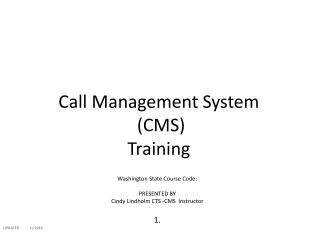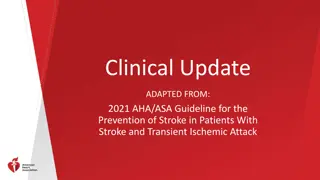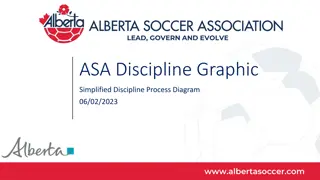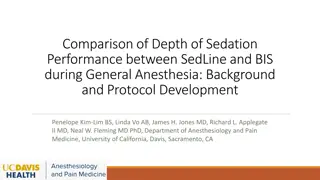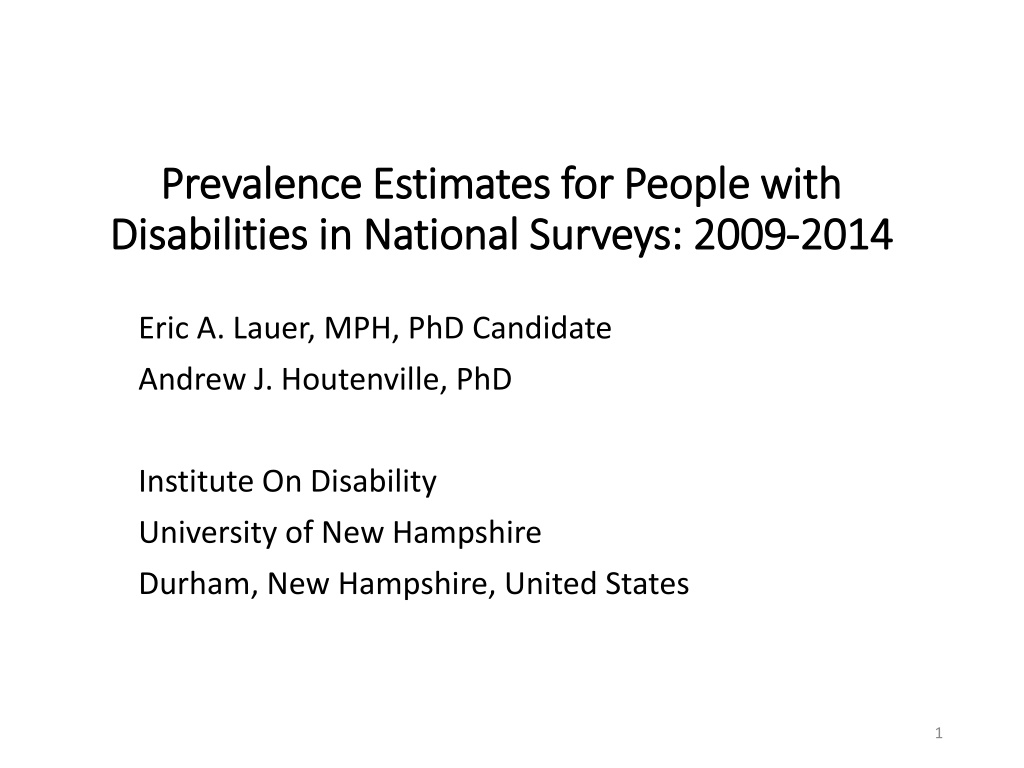
Prevalence Estimates for People with Disabilities in National Surveys 2009-2014
Explore the prevalence estimates for people with disabilities in national surveys conducted between 2009-2014, as researched by Eric A. Lauer, MPH, PhD Candidate, and Andrew J. Houtenville, PhD from the Institute on Disability at the University of New Hampshire. The study focuses on the multi-survey approach to studying disability health and the use of difficulty-related questions to identify individuals with disabilities. Various surveys like CPS-ASEC, ACS, NHIS, and SIPP were compared to analyze the varying disability estimates. This project is part of StatsRRTC, funded by the U.S. Department of Health and Human Services.
Download Presentation

Please find below an Image/Link to download the presentation.
The content on the website is provided AS IS for your information and personal use only. It may not be sold, licensed, or shared on other websites without obtaining consent from the author. Download presentation by click this link. If you encounter any issues during the download, it is possible that the publisher has removed the file from their server.
E N D
Presentation Transcript
Prevalence Estimates for People with Prevalence Estimates for People with Disabilities in National Surveys: 2009 Disabilities in National Surveys: 2009- -2014 2014 Eric A. Lauer, MPH, PhD Candidate Andrew J. Houtenville, PhD Institute On Disability University of New Hampshire Durham, New Hampshire, United States 1
Financial Disclosure & Disclaimer The following personal financial relationships with commercial interests relevant to this presentation existed during the past 12 months: No relationships to disclose The presentation is part of a project of the StatsRRTC, which is funded by the U.S. Department of Health and Human Services, National Institute for Disability, Independent Living, and Rehabilitation Research (NIDILRR) under cooperative agreement H133B130015. This presentation does not necessarily represent the policy of the Department of Health and Human Services, and you should not assume endorsement by the Federal Government (Edgar, 75.620 (b)). 2
Background In 2008, a difficulty-related question set was established as part of a multi-agency effort to identify people with disabilities in national surveys. Mandated as a data standard by the Affordable Care Act to be included in all national health surveys Consistent with the International Classification of Functioning, Disability, and Health (ICF) Using these questions, recent research has emphasized: A multi-survey approach to study the health of people with disabilities (Krahn, 2015) Studying different elements of the ICF across national surveys (Brandt, 2014) 3
Self-Report Difficulty Questions (6QS) Intended to cover six disability types: Hearing difficulty Deaf or having serious difficulty hearing. Vision difficulty Blind or having serious difficulty seeing, even when wearing glasses. Cognitive difficulty Because of a physical, mental, or emotional problem, having difficulty remembering, concentrating, or making decisions. Ambulatory difficulty Having serious difficulty walking or climbing stairs. Self-care difficulty Having difficulty bathing or dressing. Independent living difficulty Because of a physical, mental, or emotional problem, having difficulty doing errands alone such as visiting a doctor s office or shopping. United States Census Bureau, American Community Survey, History of the Disability Questions: https://www.census.gov/people/disability/methodology/acs.html 4
Methods Hypothesizing that disability estimates vary significantly between surveys, we compared estimates from the following surveys: Current Population Survey Annual Social And Economic Supplement (CPS-ASEC, 2009-2014) American Community Survey (ACS, 2009-2014) National Health Interview Survey (NHIS, 2009-2014) Survey of Income and Program Participation (SIPP, 2009-2011) Using SAS software and taking into account complex survey design methodology we used survey data to estimate counts, percentages, and standard errors of self-reported difficulty, demographic, social, and geography questions for people with and without disabilities. 5
6 *Total non-institutional civilian population, 18 and over, across surveys was approximately 231,000,000 people
Weighted percentage of adult non-institutionalized civilians with self-reported difficulties by survey and year 18.00 17.1 17.1 16.9 16.7 17.00 16.2 15.8 Weighted Percentage (95% CI) 16.00 15.4 15.4 15.2 15.2 15.6 14.7 15.00 14.7 14.6 14.5 ACS CPS-ASEC 14.00 NHIS SIPP 13.00 12.0 11.9 11.9 11.9 11.8 11.7 12.00 11.00 2009 2010 2011 2012 2013 2014 Year 7
Weighted percentage of non-institutionalized civilians with self-reported limitations in 2011, by survey and age group. 50.00 45.00 Weighted Percentage (95% CI) 40.00 35.00 30.00 25.00 20.00 15.00 10.00 5.00 0.00 SIPP SIPP SIPP SIPP SIPP SIPP NHIS NHIS NHIS NHIS NHIS NHIS ACS CPS-ASEC ACS CPS-ASEC ACS CPS-ASEC ACS CPS-ASEC ACS CPS-ASEC ACS CPS-ASEC 18 to 25 25 to 34 35 to 44 45 to 54 55 to 64 65 and older Survey & Age Group 8
Weighted percentage of adult non-institutionalized civilians with self-reported difficulties in 2011 by gender, race, ethnicity and survey. 100.00 90.00 Weighted Percentage (95% CI) 80.00 70.00 60.00 50.00 40.00 30.00 20.00 10.00 0.00 NHIS NHIS NHIS NHIS NHIS NHIS NHIS NHIS SIPP SIPP SIPP SIPP SIPP SIPP SIPP SIPP ACS ACS ACS ACS ACS ACS ACS ACS CPS-ASEC CPS-ASEC CPS-ASEC CPS-ASEC CPS-ASEC CPS-ASEC CPS-ASEC CPS-ASEC Male Female White Black Asian Other Hispanic Non- Hispanic Gender Race Ethnicity Demographic Factor 9
Risk Differences for Social Factors between Adult Non- Institutionalized Civilians with and without Self-Reported Difficulties in 2011 by Survey 15.00 10.00 5.00 0.00 -5.00 Risk Difference (95% CI) -10.00 -15.00 -20.00 -25.00 -30.00 ACS -35.00 CPS-ASEC -40.00 NHIS -45.00 SIPP -50.00 -55.00 Education Employment Family Size Health Insurance Social Factor Health Marital Status Poverty 10
Risk ratios for social factors comparing adult non- institutionalized civilians with and without self-reported difficulties in by survey A 1.0 B 2.00 0.9 1.90 0.8 1.80 0.7 Risk Ratios (95% CI) 1.70 Risk Ratio (95% CI) 0.6 1.60 0.5 1.50 0.4 1.40 0.3 1.30 0.2 1.20 0.1 1.10 0.0 1.00 SIPP SIPP SIPP SIPP SIPP ACS ACS ACS ACS ACS NHIS NHIS NHIS NHIS NHIS CPS-ASEC CPS-ASEC CPS-ASEC CPS-ASEC CPS-ASEC SIPP SIPP ACS ACS NHIS NHIS CPS-ASEC CPS-ASEC Education Employment Family Size Health Marital Status Health Insurance Social Factor Poverty Social Factor 11
Highest Highest Percentage of People with Self Percentage of People with Self- -Reported Difficulties, by Reported Difficulties, by Survey and State Survey and State 12
Lowest Lowest Percentages Percentages of People with Self of People with Self- -Reported Difficulties, by Reported Difficulties, by Survey and State Survey and State 13
Conclusion Substantial and significant variation of self-reported difficulties Replicated previous findings (Picavet, 1996) Weighting factors and unweighted sample Similar direction and magnitude of risk differences and risk ratios across demographic and social factors Estimation is highly dependent on age Similar regional estimates of self-reported difficulties, with notable state variation (U.S.) 14
Study Limitations Survey design effects Sampling and data collection methods Sample sizes Reference period of the surveys and questions Repeated interviewing (e.g. CPS and SIPP) Sampling frame and eligibility rules Item wording, nonresponse and allocation Statistical approach Unable to disentangle sampling, response and nonresponse bias and error 15
Discussion Weighting & Standardization Can we take conclusions and hypotheses drawn from one survey study them in another? Statistical significance vs. policy relevance Is variation meaningful? Counts versus percentages Moving away from International Classification of Functioning, Disability and Health? 16

